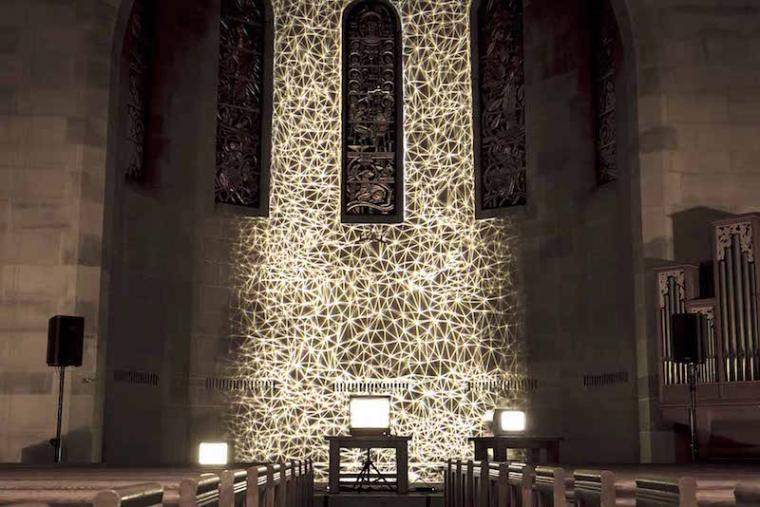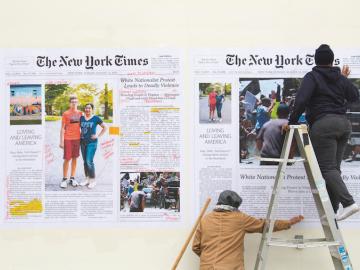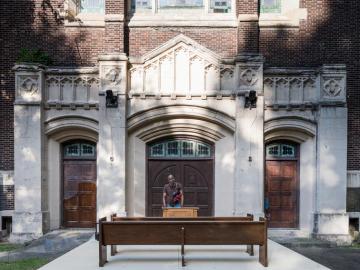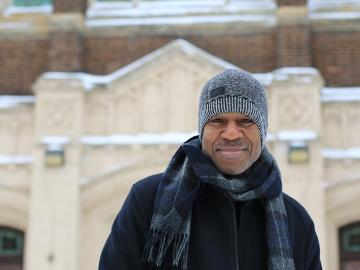Memory_Archive Explores Digital Identity
April 20, 2017
Hillary Hempstead

When it comes to socializing, fifth-year Kirk Pearson says, “The virtual version of me has a much more active social life than the actual me.”
That’s not to say that the dual degree composition and cinema studies student from New York City doesn’t talk with people in his everyday life. It does mean, however, that he admits to interacting with many more people digitally than he does physically.
“I'd say this is true for nearly every college student today. Your digital profile is really just a surrogate of you that lives in a world where geography isn’t an obstacle,” says Pearson. “It makes no difference if my friends are in California or Indonesia. I communicate with all of them using the exact same series of clicks.”
This realization about his social habits prompted Pearson to examine the implications of living such a large portion of his life online. But instead of these reflections amounting just to dorm room ponderings, Pearson pursued his musings further: “What would happen if the characteristics of the digital world started to permeate our physical lives?”
Pearson’s response to this question was to design a four-story, surrealist installation about a corporation, called memory_archive. This one-night-only show also served as Pearson’s senior recital composition piece, effectively turning the concept of the traditional senior recital on its head.
“In a typical recital, observers sit in a room to observe and listen to performances—you become a passive listener. In this recital, we bent over backwards to make sure you'd walk to, in, and out of each piece,” says Pearson. “Performers changed what they were doing, different rooms opened up at different times of the night, and different scheduled events took place at different times. Thus, no two visitors got the same experience, and we're rather proud of that.”
Set inside Oberlin’s Bosworth Hall, Pearson, with the help of a cadre of 37 student artists, programmers, performers, and designers, crafted a multi-sensory experience that explored what the digital world might look like in a physical setting. By incorporating numerous auditory and visual elements, Pearson’s depiction of a surreal world was intended to serve as a reminder that our digital identities are actually proprietary commodities.
“Your virtual self lives not in a ‘cloud,’ but in a high security cluster of corporate-controlled server farms,” says Pearson. “Every action taken by our Facebook, Twitter, or Google profiles is closely monitored and legally sold to a suite of more than 3,500 data brokering companies. There is presently no legal recourse to prevent these brokers from distributing this information to third parties, including propaganda teams, fringe political factions, or government surveillance agencies. The persona you use to communicate most frequently is also one you have no practical control over.”
Central to memory_archive was software built by student programmers who created a reactive, custom-built app that “scraped” data from each individual attendee’s Facebook profile. As a person moved through the installation, their personal information was incorporated into the art piece.
“We used Facebook's official tools to request ten photos from the people who logged into the custom built app,” says Andres Cuervo, a fourth-year studying computer science and creative writing, also worked a developer on the project. “Then we stored those in a server for use later in the show.”
The installation also used several visual techniques, one of which is called “projection mapping.” Sage Jenson, a fifth-year computer science, mathematics and TIMARA major, used projection mapping to impose patterns on the apse of the chapel inside the hall. “This allowed me to project patterns on the windows that did not touch the wall, and to light up certain bricks but not others,” says Jenson.
More than 600 people attended the performance, including some from outside of Oberlin. “The experience overall was very powerful,” says Jonah Bobo, a student visiting from the School of Music at Ithaca College. “The squeamishness of the participants when it came time to register with Facebook was so eerie. This is something people do on a daily basis without thinking twice about it. But in the context of a spooky church, and with some carefully chosen contractual language, suddenly logging into Facebook was equivalent to selling your soul to the devil.”
For Amanda Siskind, a fourth-year politics major who also stage-managed the production, a key takeaway for her was understanding the volume of personal information that is available online that can be monitored or used by anyone.
“Everything that we used in the installation, every single video clip, image, and snippet of information, was obtained legally for free and mostly without needing to ask anyone’s consent,” says Siskind. “What little we did need to ask consent for could be summed up in a 350-word terms and conditions statement, and we actually asked for far less data from participants compared to what people give up freely every day on the internet when clicking ‘OK, connect to my profile’ or ‘Yes, I agree.’ [The project] as a whole demonstrated just how much of ourselves we uncaringly put out digitally into the world, because we’re so blinded by our need for entertainment or a quicker process.”
Pearson emphasises that the installation was not intended to be a critique of Facebook. However, it was meant to be a reminder of a false sense of security that individuals have when quickly and mindlessly navigating the online world by sharing, liking, and clicking.
“As sharing is so quick and simple, we tend to blind ourselves to the content we put out there,” says Pearson. “Facebook isn't stealing your data—they've just made it blissfully simple for you to hand it over.”
Tags:
You may also like…
Counternarratives Installation Examines Bias in the News Media
October 23, 2018
Johnny Coleman: From Concept to Creation
July 25, 2018
Artist Johnny Coleman Finds Inspiration Off the Beaten Path
March 12, 2018


